Select Language
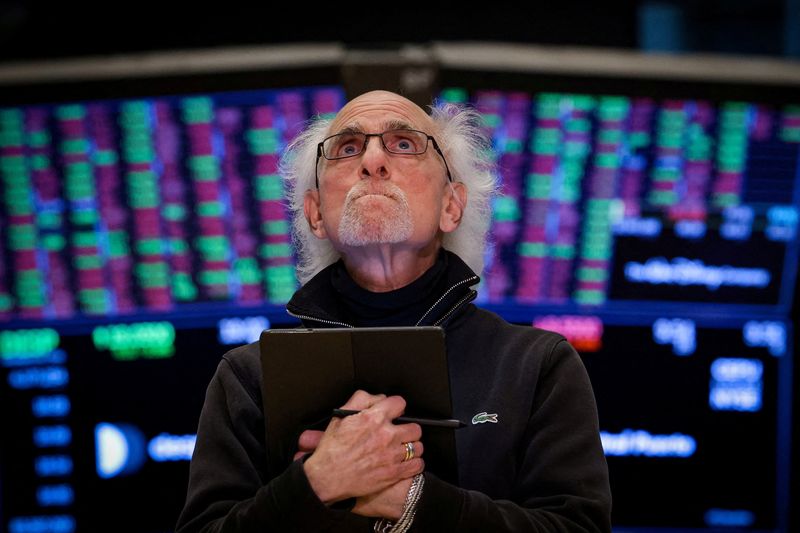
U.S. stock index futures dropped Tuesday evening after Wall Street ended sharply lower with the S&P 500 closing below 5,000, as tariffs announced by President Donald Trump were set to take effect at midnight.
President Trump signed an executive order on Tuesday to increase reciprocal tariffs on China to 84%, from 34% earlier announced on April 2. This brings total duties on China to 104%, with 20% tariffs already in place.
S&P 500 Futures dropped 1.8% to 4,929.75 points, while Nasdaq 100 Futures declined 2.2% to 16,868.50 points by 20:25 ET (00:25 GMT). Dow Jones Futures lost 1.4% to 37,325.0 points.
S&P 500 falls below 5,000 as Trump escalates trade war with China
In regular trading, Wall Street experienced significant volatility, culminating in notable declines across major indices.
The S&P 500 closed at 4,982.77, down 1.6%, marking its first close below the 5,000 threshold in nearly a year.
The Dow Jones Industrial Average also fell by 0.8%, while the NASDAQ Composite slipped 2.2%. This downturn was largely attributed to escalating trade tensions as the Trump administration prepared to implement substantial tariffs on Chinese imports.
The administration confirmed plans to impose a cumulative 104% tariff on Chinese goods, set to take effect at midnight. The tariffs include an additional 50% levy on Chinese goods, supplementing an existing 34% reciprocal tariff.
Before this, China had vowed to "fight to the end" if Trump moved ahead with his new tariff threats, further heightening investor anxiety and market instability.
Investor sentiment was initially buoyed by comments from Treasury Secretary Scott Bessent, suggesting openness to negotiations.
However, optimism faded after U.S. Trade Representative Jamieson Greer confirmed that no exemptions would be granted for products or companies affected by the new tariffs. This firm stance diminished hopes for a diplomatic resolution and contributed to the market’s reversal.
Tech slides: Tesla, Apple slump 5%
The technology sector was particularly impacted, with Apple Inc (NASDAQ:AAPL) shares dropping 4.8% to over an 11-month low.
Tesla Inc (NASDAQ:TSLA) shares slumped 5%, while market darling NVIDIA (NASDAQ:NVDA) closed 1.4% lower.
Amazon (NASDAQ:AMZN) and Meta Platforms Inc (NASDAQ:META) also suffered losses.
Broadcom Inc (NASDAQ:AVGO) closed 1.4% higher, reversing tariff losses, after it announced a new share buyback program of up to $10 billion, set to run through the end of the year.
Looking ahead, investors await consumer price index report due on Thursday for guidance on the country’s inflation outlook.

U.S. President Donald Trump on Tuesday evening signed an executive order imposing an additional 50% tariff on China, marking an escalation in an increasingly dire trade war with Beijing.
Trump signed an order increasing his reciprocal tariffs against China to 84% from a prior rate of 34%, effective from 00:01 ET (04:01 GMT), April 9.
The order comes just a day after Trump threatened to hike tariffs against China if Beijing did not withdraw its decision to impose 34% retaliatory tariffs against the U.S..
Trump’s order now brings the total tariff rate against China to 104%, well above the 60% threatened by Trump when he was campaigning for the presidency. The 84% reciprocal tariff is in addition to a 20% tariff imposed in March.
Trump’s order also increased tariffs on De Minimis goods- a class of low-value goods from China and Hong Kong that were initially exempt from any U.S. import tariffs.
China had signaled that it had no intent of backing down, with officials vowing to “fight to the end” against the U.S.. China is also expected to ramp up its stimulus measures to offset the economic headwinds from Trump’s tariffs.
Trump’s reciprocal tariffs on other major economies are also set to take effect from April 9. The U.S. President claims he is seeking to rectify allegedly “unfair” trading practices that disadvantage the U.S., and is also looking to increase U.S. manufacturing and industrial output with his tariffs.
While U.S. officials claimed that they had begun or planned talks with at least 50 countries over new trade agreements, Trump has signaled little intent to begin immediate negotiations with China.
Growing fears of a global trade war, along with disruptions for U.S. companies from Trump’s tariffs sparked steep declines in financial markets in recent sessions.

Goldman Sachs forecasts a decline in Brent and WTI oil prices to $62 and $58 per barrel, respectively, by December 2025, and further to $55 and $51 by December 2026.
These projections are based on two key assumptions: that the U.S. economy will avoid a recession due to significant tariff reductions set to commence on April 9, and that OPEC+ will moderately increase supply with two increments of 130-140kb each in June and July.
The investment bank also outlined scenarios where oil prices could deviate from these projections.
In the event of a sharp reversal in tariff policy, oil prices could exceed Goldman Sachs’ current estimates.
On the other hand, if the U.S. enters a typical recession while adhering to their OPEC baseline, Brent oil could fall to $58 per barrel by December 2025 and to $50 by the following year.
In a scenario where global GDP growth sees a slowdown, Goldman Sachs estimates Brent could drop to $54 per barrel by December 2025 and to $45 by December 2026.
“We estimate a similar price path assuming our GDP baseline and a full unwind of the 2.2mb/d of OPEC+ cuts,” strategists led by Yulia Zhestkova Grigsby wrote in a note.
In a more extreme scenario, combining a global GDP downturn with a total unwinding of OPEC+ cuts, which would in turn discipline non-OPEC supply, strategists project that Brent oil could fall to just under $40 per barrel in late 2026.
However, the strategists note that oil prices are “unlikely to fall well below $40/bbl on a sustained basis,” citing two reasons.
Firstly, U.S. shale production is likely to provide a stronger price floor at lower levels, and secondly, any potential U.S. recession in 2025 is not anticipated to be severe, partly due to the absence of significant financial imbalances in the private sector, strategists said.

By Fergal Smith
(Reuters) -Canada’s main stock index fell on Monday to a seven-month low, including declines for energy and financial shares, as a widening trade war threatened to derail the global economy and despite the prospect of negotiations that could lead to deals.
Toronto Stock Exchange’s S&P/TSX composite index ended down 334.01 points, or 1.4%, at 22,859.46, adding to steep declines on Thursday and Friday and posting its lowest closing level since September 6.
The index has fallen 11.4% since posting a record closing high on January 30. That’s a magnitude that puts it in correction territory but a smaller pullback than for some other major indexes, such as the S&P 500.
U.S. President Donald Trump said he was not looking at a pause on tariffs to allow for negotiations with trading partners but said he would talk to China, Japan and other countries about the duties.
"It looks like deals are going to be made, which is a positive, yet the market is not sure," said Allan Small, senior investment advisor of the Allan Small Financial Group with iA Private Wealth.
Energy was down 2% as the price of oil extended its recent declines, settling 2.1% lower at $60.70 a barrel, on worries that tariffs could push economies around the world into recession.
Heavily weighted financials also lost 2%, with Great-West Lifeco Inc (TSX:GWO) down 5.1%.
Consumer staples ended 2.8% lower. Shares of Loblaw Companies Ltd (TSX:L) declined 3.2%, extending their pullback from a record high on Thursday.
The probability of a U.S. recession has risen significantly thanks to Trump’s tariffs and that will have a major negative effect on the Canadian economy, Prime Minister Mark Carney said.
Canadian firms and consumers see a sharply higher chance of recession over the coming year as U.S. tariffs and possible retaliation fuel widespread uncertainty, the Bank of Canada said.
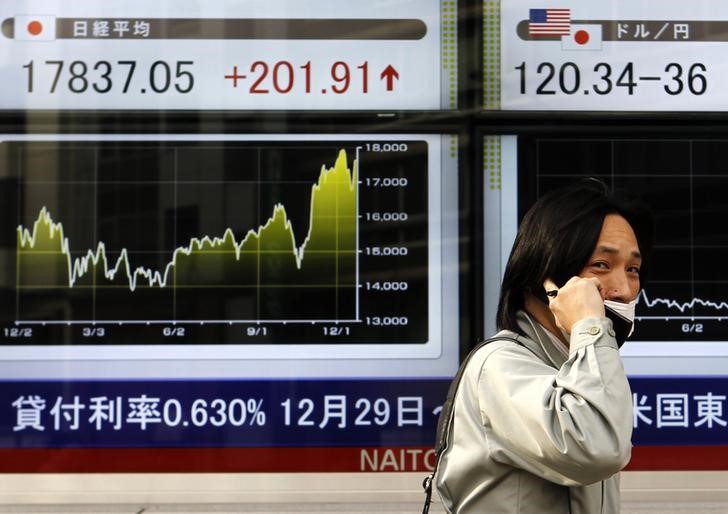
Asian stock markets staged a modest recovery on Tuesday, rebounding from the previous session’s steep losses driven by escalating global trade tensions.
Most regional stock indices saw sharp gains helped by an overnight bounce back in U.S. technology stocks, while some dip-buyers emerged after three days of sharp declines.
Major U.S stock indexes closed slightly lower on Monday, while the tech-heavy Nasdaq inched up. Futures tied to these benchmark indexes jumped in Asian trading on Tuesday.
However, investors were cautious due to an escalating global trade. U.S. President Donald Trump on Monday threatened more tariffs on China, which faced retaliatory vows from Beijing.
Japan stocks surge on tech boost, weaker yen
Japan’s Nikkei 225 index led the resurgence, soaring nearly 7%, after heavy declines in the previous three sessions.
The broader TOPIX index also experienced significant gains, rising more than 7%.
The rebound was bolstered by a weakening yen and a surge in technology stocks.
Chip-related companies such as Tokyo Electron (TYO:8035) and Advantest Corp. (TYO:6857) saw their shares jump over 10% and 12%, respectively. SoftBank Group Corp. (TYO:9984) also climbed over 12%, contributing to the market’s recovery.
The yen’s reversal from its recent gains alleviated pressure on Japanese exporters.
Trump threatens extra tariffs on China; Beijing vows to retaliate
President Trump further escalated tensions with Beijing on Monday by threatening to impose an additional 50% tariff on Chinese goods if China does not reverse its recent 34% tariff hike on American imports by April 8.
China responded swiftly, with its Ministry of Commerce saying it would "fight to the end" and implement countermeasures if the U.S. follows through.
China already faces a combined 54% tariffs, with the recent 34% reciprocal duties announced on April 2.
UBS estimates that if tariffs stay in place, China’s 2025 export growth could fall by 5 percentage points and GDP growth by 1.5 points. Revenues for A-share non-financial firms may drop by 2.4 points, with net profit growth slowing by 6 points due to weaker margins.
However, Chinese shares were higher on Tuesday after several Chinese state-owned firms pledged to boost equity investments, as Beijing moved to shore up markets rattled by U.S. tariff tensions.
China’s central bank said Tuesday it supported state-owned Central Huijin Investment in boosting its holdings of index funds and will offer re-lending support if needed to help stabilize markets.
The blue-chip Shanghai Shenzhen CSI 300 index rose 0.5%, while the Shanghai Composite gained 0.7%.
Hong Kong’s Hang Seng jumped as much as 3%, after plunging more than 15% in the previous session.
Australia shares rise 2%, Singapore stocks decline
Australia’s S&P/ASX 200 rose nearly 2%, rebounding from a one-year low reached on Monday.
Futures for India’s Nifty 50 indicated a sharp rise at open on Tuesday.
South Korea’s KOSPI rose 1%.
Bucking the regional trend, Singapore’s Straits Times Index extended declines, dropping more than 2%.
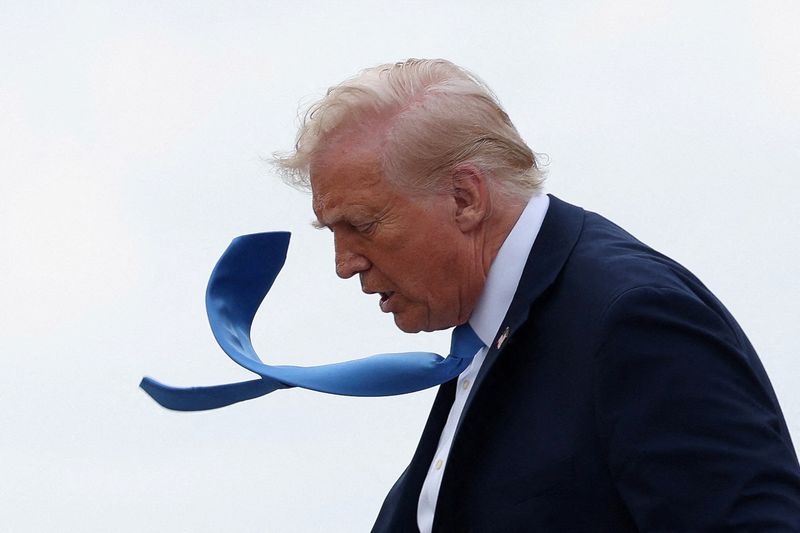
Monday’s declaration by U.S. President Donald Trump indicates a further escalation in the trade tensions between the United States and China. Trump, in a post on Truth Social media, has stated that the United States will impose an additional 50% tariff on Chinese goods if China does not rescind its recent 34% tariff hike by April 8, 2025. This ultimatum follows China’s retaliatory tariffs and other trade practices that Trump has labeled as abusive.
The new tariff escalation from Trump comes despite markets around the world being rocked by Trump’s reciprocal tarrif announcement last Wednesday. The S&P 500 lost over 10% last week since the announcement and is down another 1.8% today, accelerating losses following the social media post.
In his message, President Trump criticized China for its imposition of a 34% retaliatory tariff, which he views as an addition to its "already record-setting tariffs, non-monetary tariffs, illegal subsidization of companies, and massive long-term currency manipulation." He emphasized that any country retaliating against the U.S. with additional tariffs would face immediate and substantially higher tariffs from the U.S. in response.
Trump’s post clarified the consequences for China if it fails to withdraw the tariff increase. He stated that the new U.S. tariffs would be effective from April 9th. In addition to the tariff threat, Trump also announced that all discussions with China regarding their requested meetings would be terminated if they do not comply with the U.S. demands.
The President’s message comes in the wake of what he describes as China’s long-term tariff abuse of the U.S. He has previously warned that retaliation by any country with additional tariffs would be met with a significant response from the U.S. In his post, he also mentioned that the United States would begin immediate negotiations with other countries that have sought meetings, signaling a shift in diplomatic engagement away from China.
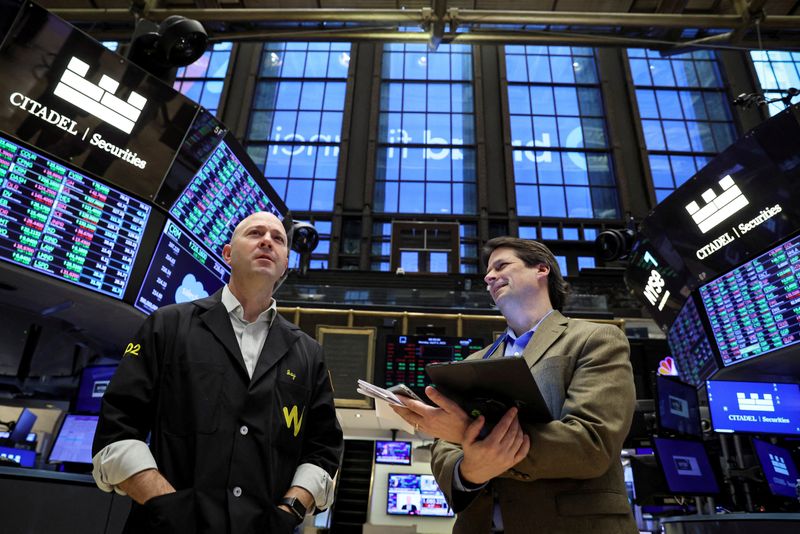
S&P 500 stocks cut some losses Monday, but ultimately ended lower after swinging widely during the session amid ongoing speculation on whether President Donald Trump will offer countries a path toward negotiating reprieves on tariffs.
At 4:00 p.m. ET, the Dow Jones Industrial Average dropped 349 points, or 1.2%, the S&P 500 index gained 0.2%, while the NASDAQ Composite added 0.04%.
The benchmark indices had opened sharply lower Monday, continuing the selloff seen at the end of last week, which had seen the broad-based S&P 500 index tumble over 10%, erasing nearly $5 trillion in market value, marking its most significant two-day loss since March 2020, the onset of the COVID-19 pandemic.
Trump reiterates no pause on tariffs; threatens to raise China tariffs following retaliation; talks to start with Japan
In a press briefing on Monday, Trump reiterated that the United States wasn’t considering pausing the reciprocal tariffs that have wrecked havoc on markets.
Earlier in the session, stock saw a brief reprieve on unconfirmed reports that U.S. President Donald Trump was considering pausing his sweeping trade tariffs for 90 days on all countries except China. The White House later debunked this as "fake news", but the short-term jump in stocks illustrates the jitteriness of the market after two brutal days of selling.
Trump, in a post on Truth Social media shortly after 11 AM ET, stated that the United States will impose an additional 50% tariff on Chinese goods if China does not rescind its recent 34% tariff hike by April 8, 2025. This ultimatum follows China’s retaliatory tariffs and other trade practices that Trump has labeled as abusive.

By Sukriti Gupta and Medha Singh
(Reuters) -European shares plunged to a 16-month low on Monday as investors grappled with the possibility of a recession after U.S. President Donald Trump showed no signs of letting up in his aggressive trade war.
The pan-European STOXX 600 slumped 5.8% at 0722 GMT, down for the fourth straight session and on track for its steepest one-day percentage decline since the COVID-19 pandemic.
Trade-sensitive Germany’s benchmark index dove 6.1%, among the worst hit markets in the euro area. At one point the index was down more than 20% from its March all-time closing high. The index would confirm it has been in a bear market if it closes at session lows.
Over the weekend Trump told reporters that investors would have to take their medicine and he would not do a deal with China until the U.S. trade deficit was sorted out, sparking a fresh wave of selling in Asian markets. [MKTS/GLOB]
"There was some hope over the weekend that maybe we would see the start of a negotiation, but the messages that we’ve so far seen suggest that President Trump is comfortable with the market reaction and that he’s going to continue on this course," said Richard Flax, chief investment officer at Moneyfarm.
European banks were on pace to confirm a bear market with Commerzbank (ETR:CBKG) and Deutsche Bank shedding 10.7% and 10%, respectively on Monday.
Investors also booked gains in shares of arms makers, which had surged earlier this year on prospect of higher defence spending. Tankmaker Rheinmetall (ETR:RHMG) dropped 10%, while Hensoldt, Rheinmetall and Renk fell between 8% and 12%.
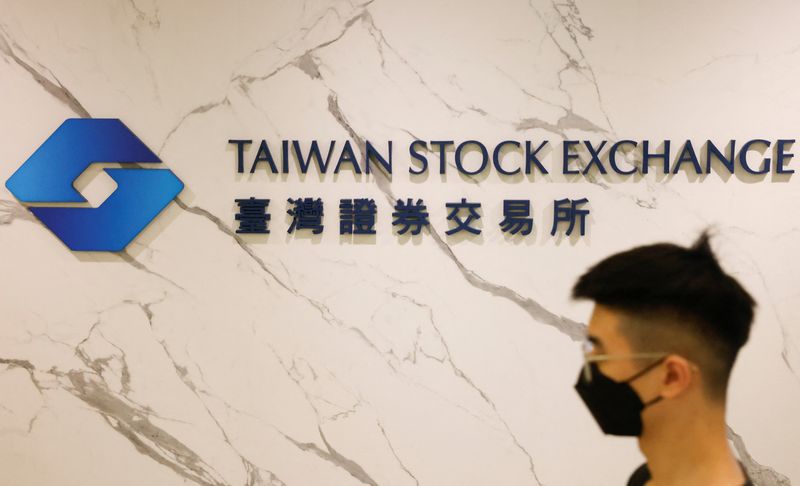
By Roger Tung and Faith Hung
TAIPEI (Reuters) -Taiwan stocks plummeted almost 10% on Monday in their first trading since the United States announced new import tariffs last week, as Taiwan President Lai Ching-te took to X to pledge in English a "golden age" of shared prosperity with the U.S.
Taiwan, hit with a 32% duty, was singled out by U.S. President Donald Trump as among the U.S. trading partners with one of the highest trade surpluses with the country.
After resuming trade on Monday following market holidays on Thursday and Friday, Taiwan’s benchmark stock index plunged to its lowest level in more than a year and its biggest one-day percentage drop since at least 1990, according to LSEG data.
Taiwan on Friday announced a T$88 billion ($2.65 billion) support package for companies hit by the tariffs, while Lai on Sunday said the island would buy more from and invest more in the United States, with the aim of a zero-tariff regime between the two.
On his X account on Monday, Lai reiterated he did not seek retaliatory tariffs and that "we’ll start talking from bilateral ’zero tariffs’."
"To ensure Taiwan’s competitiveness, we’ll increase US imports & adopt other measures. Working together, we’ll usher in a golden age of shared prosperity," he added.
Taiwan has long sought a free trade deal with the United States.
While semiconductors, Taiwan’s main manufacturing strength, are not included in Trump’s tariffs, Taiwan has a trade-dependent economy highly reliant on its part in the global electronics supply chain for everything from smartphones to cars.
Shares in chipmaker TSMC and electronics maker Foxconn (SS:601138) both fell near 10%, triggering the 10% circuit breaker in the Taiwan market. "The panic selling pressure is very high," said Venson Tsai, an analyst at Cathay Futures in Taipei. "This is a problem of market confidence."
Taiwan’s top financial regulator on Sunday announced it would impose temporary curbs lasting all this week on short-selling of shares to help deal with potential market turmoil from the tariffs.
Speaking to reporters shortly after the market opened, Taiwan Stock Exchange Chairman Sherman Lin said it would coordinate with the financial regulator to take further stabilisation steps if needed.
The stock exchange will maintain flexibility in stabilisation measures this week to handle volatility stemming from new U.S. import tariffs, Lin added.
He said it would be hard for Taiwan to escape the market impact of the tariffs, but called on investors to have confidence in Taiwanese companies and the government.
Allen Huang, a vice president of Mega Financial’s securities investment unit, said in a worst-case scenario, the chance of a recession could be higher than 50%.
"We’re not expecting Trump to change his policy in the near term," he said.
Goldman Sachs downgraded Taiwan to "underweight" in its Asian market allocations on Sunday, citing high exposure to U.S. exports and market sensitivity.
($1 = 33.2020 Taiwan dollars)

By Kevin Buckland
TOKYO (Reuters) -Japan’s Nikkei share average tumbled nearly 9% early on Monday, while an index of Japanese bank stocks plunged as much as 17%, as concerns over a tariff-induced global recession continued to rip through markets.
The Nikkei dropped as much as 8.8% to hit 30,792.74 for the first time since October 2023, before entering the midday trading recess down 6.5% at 31,591.84.
All 225 component stocks of the index were in the red.
The broader Topix sank as much as 9.6% before ending the morning session down 6.5%.
Speaking on Sunday aboard Air Force One, U.S. President Donald Trump characterized his latest round of sweeping tariffs as "medicine" aimed to rectify trade imbalances, and signalled a willingness to accept the market rout that followed.
Since Trump revealed the more aggressive-then-anticipated levies last week, the Nikkei has tumbled 11.6% and the U.S. S&P 500 has dropped 10.6%.
"It’s extremely difficult to judge how far this stock market correction will run (but) as long as there exists a lack of clarity of tariffs and each country’s response, the market will remain heavy," said Maki Sawada, an equities strategist at Nomura Securities.
At the same time, "the market currently is only pricing in bad news", so if there are signs of flexibility on tariffs or the announcement of economic support measures, "it’s highly likely we’ll see a bottom form in the market," Sawada said.
A topix index of banking shares slumped as much as 17.3% on Monday, before recovering slightly to enter the midday recess down 9.8%.

